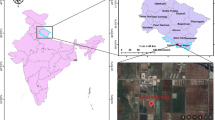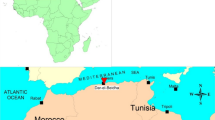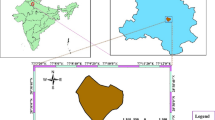Abstract
Accurate estimating of reference evapotranspiration (ETo) is of great importance for achieving irrigation scheduling and water management studies. In the absence of lysimeters measurements, which is common in many developing countries, ETo estimating represents a real challenge for the water planners community, they often have recourse to less required-data empirical equations that are frequently associated with low accuracies, or to the well-known Food and Agriculture Organization Penman–Monteith (FAO–PM) equation that necessitates a large number of climatic parameters. The present study aims to develop regional data-driven models for ETo estimating that require a limited number of measured climatic inputs (MCI) coupled with geographic coordinates as auxiliary variables. It explores two modeling methods, namely factorial (FR) and support vector machines (SVMR) regressions. The used data concerned 45 meteorological stations, situated in different climatic zones in northwestern Africa, gathered from FAO databases. Pearson matrix of correlation coefficients was used to explore the most important input combinations. The obtained FR and SVMR models were evaluated relative to FAO–PM equation estimates using the root mean square error (RMSE), the correlation coefficient (R), the RMSE–observations standard deviation ratio (RSR), and the mean absolute error (MAE). The results showed that both explored methods gave satisfactory results with a slight superiority of the SVMR that gave more accurate models. Four models (two FRs and two SVMRs) were pointed out depending on the number of MCI. The best models including two MCI were, FR-BS11 and SVMR11, with RMSEs values of 0.28 and 0.29 mm day−1, respectively; those including three MCI were, SVMR8 and FR-BS8, with RMSEs values of 0.19 and 0.20 mm day−1, respectively. The overall results were useful when dealing with limited MCIs in the study area.









Similar content being viewed by others
References
Ahmadi F, Mehdizadeh S, Mohammadi B, Pham QB, Doan TNC, Vo ND (2021) Application of an artificial intelligence technique enhanced with intelligent water drops for monthly reference evapotranspiration estimation. Agric Water Manag 244:106622
Alizamir M, Kisi O, Muhammad Adnan R, Kuriqi A (2020) Modelling reference evapotranspiration by combining neuro-fuzzy and evolutionary strategies. Acta Geophys 68:1113–1126
Allen RG, Pereira LS, Raes D, Smith M (1998) Crop evapotranspiration-Guidelines for computing crop water requirements-FAO Irrigation and drainage paper 56
Bellido-Jiménez JA, Estévez J, García-Marín AP (2021) New machine learning approaches to improve reference evapotranspiration estimates using intra-daily temperature-based variables in a semi-arid region of Spain. Agric Water Manag 245:106558
Cady F (2017) The data science handbook, 2017th edn. John Wiley & Sons Inc, New Jersey
Cohen J, Cohen P, West G, Aiken S, Leona S (2003) Applied multiple regression correlation analysis for the behavioral sciences, 3rd edn. Lawrence Erlbaum Associates Inc, New Jersey
Djaman K, Koudahe K, Lombard K, O’Neill M (2018) Sum of hourly vs. daily Penman-Monteith grass-reference evapotranspiration under semiarid and arid climate. Irrig Drain Syst Eng 07(1):1–6
FAO (2001) FAOCLIM 2.0, world-wide Agroclimatic data of FAO. FAO, Rome
Ferreira LB, da Cunha FF (2020) Multi-step ahead forecasting of daily reference evapotranspiration using deep learning. Comput Electron Agric 178:105728
Ferreira LB, da Cunha FF, de Oliveira RA, Fernandes Filho EI (2019) Estimation of reference evapotranspiration in Brazil with limited meteorological data using ANN and SVM—a new approach. J Hydrol 572:556–570
Ferreira LB, da Cunha FF, Fernandes Filho EI (2022) Exploring machine learning and multi-task learning to estimate meteorological data and reference evapotranspiration across Brazil. Agric Water Manag 259:107281
Frost MSJ (2020) Regression analysis: an intuitive guide for using an interpreting linear models, 1st edn. Statistics By Jim Publishing, Pennsylvania
Gong D, Hao W, Gao L, Cui N (2021) Extreme learning machine for reference crop evapotranspiration estimation: model optimization and spatiotemporal assessment across different climates in China. Comput Electron Agric 187:106294
IC National (2009) North Africa: the impact of climate change to 2030 (selected countries). National IC, Florida
Kisi O, Keshtegar B, Zounemat-Kermani M, Heddam S, Trung NT (2021) Modeling reference evapotranspiration using a novel regression-based method: radial basis M5 model tree. Theor Appl Climatol 145(1):639–659
Kutner MH, Nachtsheim CJ, Neter J, Li W (1997) Applied linear statistical models, 5th edn. McGraw-Hill Irwin, New York
Laaboudi A, Mouhouche B, Draoui B (2012) Neural network approach to reference evapotranspiration modeling from limited climatic data in arid regions. Int J Biometeorol 56(5):831–841
Langhammer J, Česák J (2016) Applicability of a nu-support vector regression model for the completion of missing data in hydrological time series. Water (switzerland) 8(12):560–585
Mehdizadeh S, Behmanesh J, Khalili K (2017) Using MARS, SVM, GEP and empirical equations for estimation of monthly mean reference evapotranspiration. Comput Electron Agric 139:103–114
Mohammadi B, Mehdizadeh S (2020) Modeling daily reference evapotranspiration via a novel approach based on support vector regression coupled with whale optimization algorithm. Agric Water Manag 237:106145
Montgomery DC, Peck EA, Vining GG (2012) Introduction to linear regression analysis, 5th edn. John Wiley & Sons Inc, New Jersey
Moriasi DN, Arnold JG, Van Liew MW, Bingner RL, Harmel RD, Veith TL (2007) Model evaluation guidelines for systematic quantification of accuracy in watershed simulations. Trans ASABE 50(3):885–900
Ponraj AS, Vigneswaran T (2020) Daily evapotranspiration prediction using gradient boost regression model for irrigation planning. J Supercomput 76(8):5732–5744
Raghavendra S, Deka PC (2014) Support vector machine applications in the field of hydrology: a review. Appl Soft Comput J 19:372–386
Ravindran SM, Bhaskaran SKM, Ambat SKN (2021) A deep neural network architecture to model reference evapotranspiration using a single input meteorological parameter. Environ Process 8:1567–1599
Roy DK, Lal A, Sarker KK, Saha KK, Datta B (2021) Optimization algorithms as training approaches for prediction of reference evapotranspiration using adaptive neuro fuzzy inference system. Agric Water Manag 255:107003
Savva AP, Frenken K (2002) Crop water requirements and irrigation scheduling. FAO Sub-Regional Office for East and Southern Africa, Harare
Sheldon MR (2010) Introductory statistics, 3rd edn. Elsevier Inc, Oxford
Singh J, Knapp HV, Arnold JG, Demissie M (2005) Hydrological modeling of the Iroquois River watershed using HSPF and SWAT. J Am Water Resour Assoc 41(2):343–360
Smith M (1995) CLIMWAT for CROPWAT: a climatic database for irrigation planning and management. FAO, Rome
Smola AJ, SchOlkopf B (2004) Statistics and computing a tutorial on support vector regression. Stat Comput 14(3):199–222
StatSoft Inc (2011) Statistica version 10.0, data analysis software system. StatSoft, Tulsa
Tabari H, Kisi O, Ezani A, Hosseinzadeh Talaee P (2012) SVM, ANFIS, regression and climate based models for reference evapotranspiration modeling using limited climatic data in a semi-arid highland environment. J Hydrol 444–445:78–89
Talib A, Desai AR, Huang J, Griffis TJ, Reed DE, Chen J (2021) Evaluation of prediction and forecasting models for evapotranspiration of agricultural lands in the Midwest U.S. J Hydrol 600:126579
Vapnik VN (1995) The nature of statistical learning theory, vol 10. Springer, New York, pp 250–320
Yirga SA (2019) Modelling reference evapotranspiration for Megecha catchment by multiple linear regression. Model Earth Syst Environ 5(2):471–477
Yu H, Wen X, Li B, Yang Z, Wu M, Ma Y (2020) Uncertainty analysis of artificial intelligence modeling daily reference evapotranspiration in the northwest end of China. Comput Electron Agric 176:105653
Author information
Authors and Affiliations
Corresponding author
Ethics declarations
Conflict of interest
The authors have no relevant financial or non-financial interests to disclose. The authors have no competing interests to declare that are relevant to the content of this article. All authors certify that they have no affiliations with or involvement in any organization or entity with any financial interest or non-financial interest in the subject matter or materials discussed in this manuscript. The authors have no financial or proprietary interests in any material discussed in this article. The datasets generated during and/or analysed during the current study are available from the corresponding author on reasonable request.
Additional information
Publisher's Note
Springer Nature remains neutral with regard to jurisdictional claims in published maps and institutional affiliations.
Rights and permissions
About this article
Cite this article
Zereg, S., Belouz, K. Prediction of reference evapotranspiration in northwestern Africa with limited data using factorial and SVM regressions. Model. Earth Syst. Environ. 8, 5129–5142 (2022). https://doi.org/10.1007/s40808-022-01428-0
Received:
Accepted:
Published:
Issue Date:
DOI: https://doi.org/10.1007/s40808-022-01428-0




